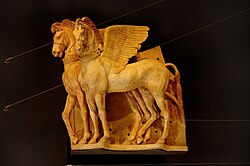Germanic

- Árvakr and Alsviðr, horses that pull Sól's chariot [27]
- Blóðughófi, Freyr's horse [28]
- Falhófnir, a horse of the gods [29]
- Falke (ON Falka), horse of þidrekr (Dietrich von Bern); sibling horse of Rispe and Schimming ( qq.v ). [30] [31]
- Glaðr, a horse of the gods [32]
- Glær, a horse listed in both the Grímnismál and Gylfaginning [33]
- Goti, horse of Gunnar [34] (≈Gunther of the Nibelingenlied)
- Grani, the horse of Sigurð [35]
- Gullfaxi or Golden Mane, originally owned by Hrungnir, given to Magni
- Gullfaxi in the fairytale "The Horse Gullfaxi and the Sword Gunnfoder"
- Gulltoppr, the horse of Heimdallr [36]
- Gyllir, a horse whose name translates to "the golden coloured one" [37]
- Hamskerpir and Garðrofa, the parents of Hófvarpnir [38]
- Hófvarpnir, horse of the goddess Gná [27]
- Hölkvir, horse of Högni [39] (≈Hagen)
- Hrímfaxi or Rime-frost Mane, Nótt (Night)'s horse [40]
- Leo or Lion, of Waltharius of Aquitaine. [41]
- Lewe (Löwe, Lion), of Master Hildebrand. [42]
- Skinfaxi or Shining Mane, Dagr (Day)'s horse [43]
- Rispe (ON Rispa), Heime's horse. [44] [31]
- Schimming (ON Skemmingr), Witege's horse. [30] [31]
- Sleipnir, Odin's eight-legged horse [45]
- Slungnir (aka Slöngvir [46] ), horse of King Adils of Sweden, stolen by Hrólfr Kraki [47]
- Svaðilfari, the stallion that fathered Sleipnir [48]
